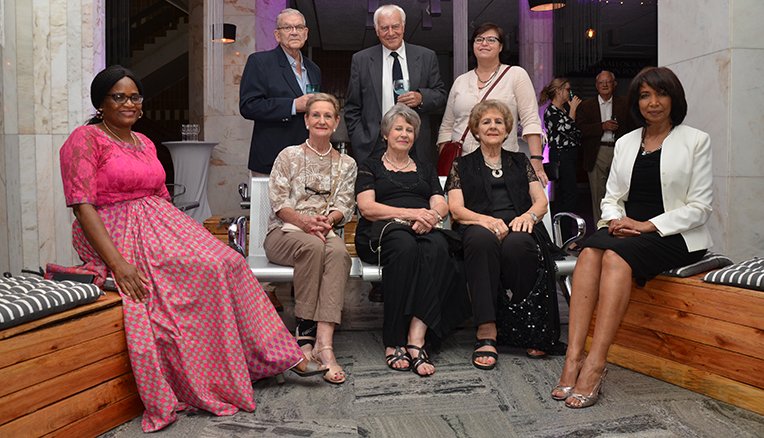The
Faculty of Health Sciences at the University of the Free State (UFS) kicked of its 50-year anniversary celebrations on Tuesday night (10 March) with a cocktail function and some entertaining stories from the old days by one of its former heads of department.
Prof Philip Badenhorst, a former Head of the Department of Haematology and Cell Biology, had the crowd of distinguished guests – including
Prof Francis Petersen, Rector and Vice-Chancellor of the UFS, Prof Gert van Zyl, Dean of the faculty, other heads of department and former heads of schools, as well as deans from other faculties – in stitches with tales from days gone by.
Among the other guests in the Francois Retief Building were also members of the alumni, student representatives, and private hospital managers.
Prof Badenhorst, who started working in Bloemfontein in December 1969 and retired forty years later in 2009, said he had the privilege of witnessing first-hand the founding and development of the faculty.
“I have witnessed the faculty grow from a bare field to the completion of a striking building complex; from a few staff members to an institution on par with the best by the time I left. I witnessed achievements that have astonished the world,” he said before going on to reflect on some funny incidents.
Prof Van Zyl, who did the welcoming, gave a brief history of the establishment of the faculty and highlighted some important dates.
“Let me start by saying, where were you 50 years ago? What an achievement. This is the first of our celebrations for our 50-year anniversary. But I need to say immediately, it didn’t start 50 years ago. When I looked at the history of the faculty, it already started in 1950.”
“I need to go back to the first official reference to medical training, and that was already in 1950 when the Brebner Commission into dental and medical education announced that they think there should be medical schools, as defined in the writings of Prof FP Retief, the founding dean. They announced that there were three areas and identified the Free State as their preference for a medical school.”
According to the references, the announcement of a medical school in the Free State only came on 6 June 1969 at the official opening of the OFS Institute of Isotopes and Radiation, when Minister CPC de Wet informed the approximately 450 ecstatic guests that the government had decided in principle to establish, in time, medical training facilities at three universities, namely the University of the Orange Free State, RAU, and the University of Natal.

Seated: Prof Joyce Tsoka-Gwegweni: Vice Dean – Research, Transformation and Marketing: Faculty of Health Sciences, Mrs Marietjie Claassen, Prof Tiney Crous, Mrs Marié Potgieter
and Prof Jocelyn Naiker (MC) Back: Prof Jan Botha (previous Head: Forensic Medicine), Prof John Shipley (previous Head: Orthopaedic Surgery), Porf Corli Witthuhn
(Vice-Rector: Research, Innovation and Internationalisation)
The first employee of the new faculty was Mr MJ (Boffie) Strydom who was appointed as assistant registrar on 21 July. He commenced duty on 1 October and would play a remarkable role as Chief Administrative Officer in the faculty until his retirement in 1986. In recognition of his role, the central committee room in the faculty was named after him after his death. Prof FP Retief, the first Dean, commenced duty on 1 January 1970.
Other important dates include:• On 16 February 1970, the JSAC convened for the first time and established the core of the future academic staff structure.
• On 23 February, sketch plans and costings regarding the faculty building were submitted to the Executive Committee (EC) of the Council.
• A preliminary Faculty Council meeting was held in the tearoom of the National Hospital on 14 September 1970, followed by the first full status Faculty Board meeting on 25 February 1971.
• The first students to register at the faculty on 26 June, were eleven postgraduate MMed students.
• The first intake of first-year students was in February 1971.
• On 20 March 1978, the faculty building was formally opened.